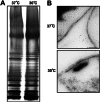Analysis of Soluble protein complexes in Shigella flexneri reveals the influence of temperature on the amount of lipopolysaccharide
- PMID: 23378524
- PMCID: PMC3650336
- DOI: 10.1074/mcp.M112.025270
Analysis of Soluble protein complexes in Shigella flexneri reveals the influence of temperature on the amount of lipopolysaccharide
Abstract
Shigella flexneri, which is closely related to Escherichia coli, is the most common cause of the endemic form of shigellosis. In this study, 53 homomultimeric protein complexes and nine heteromultimeric protein complexes from S. flexneri 2a strain 2457T were separated and identified. Among these, three potential homomultimeric protein complexes had not been previously described. One complex, thought to be composed of 12 PhoN1 subunits, is a periplasmic protein with an unknown physiological role encoded on the virulence plasmid of S. flexneri. The abundance of the protein complexes was compared following growth at 37 or 30°C, and the abundance of three protein complexes (PyrB-PyrI, GlmS, and MglB) related to the synthesis of lipopolysaccharides (LPS) appeared to be temperature-dependent. Many studies have shown that LPS is essential to the virulence of S. flexneri. Here, we report the influence of temperature on the amount of LPS.
Figures






Similar articles
-
The proteome of Shigella flexneri 2a 2457T grown at 30 and 37 degrees C.Mol Cell Proteomics. 2010 Jun;9(6):1209-20. doi: 10.1074/mcp.M900446-MCP200. Epub 2010 Feb 17. Mol Cell Proteomics. 2010. PMID: 20164057 Free PMC article.
-
Immunoproteome analysis of soluble and membrane proteins of Shigella flexneri 2457T.World J Gastroenterol. 2006 Nov 7;12(41):6683-8. doi: 10.3748/wjg.v12.i41.6683. World J Gastroenterol. 2006. PMID: 17075984 Free PMC article.
-
Analysis of the proteome of intracellular Shigella flexneri reveals pathways important for intracellular growth.Infect Immun. 2013 Dec;81(12):4635-48. doi: 10.1128/IAI.00975-13. Epub 2013 Oct 7. Infect Immun. 2013. PMID: 24101689 Free PMC article.
-
Analysis of Shigella flexneri Resistance, Biofilm Formation, and Transcriptional Profile in Response to Bile Salts.Infect Immun. 2017 May 23;85(6):e01067-16. doi: 10.1128/IAI.01067-16. Print 2017 Jun. Infect Immun. 2017. PMID: 28348056 Free PMC article.
-
Shigella flexneri: genetics of entry and intercellular dissemination in epithelial cells.Curr Top Microbiol Immunol. 1994;192:217-41. doi: 10.1007/978-3-642-78624-2_10. Curr Top Microbiol Immunol. 1994. PMID: 7859507 Review. No abstract available.
Cited by
-
Role of the virulence plasmid in acid resistance of Shigella flexneri.Sci Rep. 2017 Apr 25;7:46465. doi: 10.1038/srep46465. Sci Rep. 2017. PMID: 28440329 Free PMC article.
-
How does Helicobacter pylori cause gastric cancer through connexins: An opinion review.World J Gastroenterol. 2019 Sep 21;25(35):5220-5232. doi: 10.3748/wjg.v25.i35.5220. World J Gastroenterol. 2019. PMID: 31558869 Free PMC article. Review.
-
UV-C Adaptation of Shigella: Morphological, Outer Membrane Proteins, Secreted Proteins, and Lipopolysaccharides Effects.Curr Microbiol. 2017 Nov;74(11):1261-1269. doi: 10.1007/s00284-017-1311-1. Epub 2017 Jul 25. Curr Microbiol. 2017. PMID: 28744569
-
Bacterial lysis or survival after infection with phage Sf14 depends on combined nutrient and temperature conditions.PLoS One. 2025 Mar 25;20(3):e0319836. doi: 10.1371/journal.pone.0319836. eCollection 2025. PLoS One. 2025. PMID: 40132034 Free PMC article.
-
The tal gene of lactococcal bacteriophage TP901-1 is involved in DNA release following host adsorption.Appl Environ Microbiol. 2024 Sep 18;90(9):e0069424. doi: 10.1128/aem.00694-24. Epub 2024 Aug 12. Appl Environ Microbiol. 2024. PMID: 39132999 Free PMC article.
References
-
- Wodak S. J., Pu S., Vlasblom J., Séraphin B. (2009) Challenges and rewards of interaction proteomics. Mol. Cell. Proteomics 8, 3–18 - PubMed
-
- Lasserre J. P., Beyne E., Pyndiah S., Lapaillerie D., Claverol S., Bonneu M. (2006) A complexomic study of Escherichia coli using two-dimensional blue native/SDS-polyacrylamide gel electrophoresis. Electrophoresis 27, 3306–3321 - PubMed
-
- Zhu L., Liu X., Zheng X., Bu X., Zhao G., Xie C., Zhang J., Li N., Feng E., Wang J., Jiang Y., Huang P., Wang H. (2010) Global analysis of a plasmid-cured Shigella flexneri strain: new insights into the interaction between the chromosome and a virulence plasmid. J. Proteome Res. 9, 843–854 - PubMed
Publication types
MeSH terms
Substances
LinkOut - more resources
Full Text Sources
Other Literature Sources

